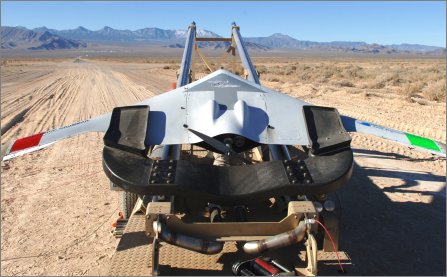Northrop Grumman has demonstrated its private-venture Killer Bee low-altitude, long-endurance unmanned air vehicle for the US Air Force, as industry awaits a US Marine Corps request for proposals for a divisional/regimental unmanned aircraft system to enter service in 2010.
|
| Long endurance Killer Bee will contest the USMC's Tier 2 UAV requirement |
The USMC’s planned Tier 2 UAV would take over the role now being performed by the Boeing/Insitu ScanEagle under a services contract. Since August 2004, the ScanEagle has logged more than 10,000 combat flight hours in Iraq, with the long-endurance UAV also expected to be offered for the Tier 2 requirement.
Although a flying-wing design reminiscent of earlier Northrop aircraft, the Killer Bee UAV was conceived and built by California-based racecar manufacturer Swift Engineering. The two companies have teamed to offer the UAV for emerging USAF, USMC and US Coast Guard requirements.
The pusher-propeller blended wing-body design provides aerodynamic efficiency, stability and fuel and payload capacity for long endurance at low altitude, says Bill Walker, director of business development for the Killer Bee. With a payload of up to 13.5kg (30lb), the 2.7m (9ft)-span KB-3 variant has a 24h endurance at 3,000ft (900m) and 60kt (110km/h), he says.
As demonstrated to the USAF at Creech AFB, Nevada during March, the autonomous Killer Bee has two separate electro-optical sensor turrets on the centre of gravity under the wing – one visible and one infrared. “We can fly both day and night without changing the sensor,” says Walker.
Northrop plans to fly small radar and signals-intelligence payloads in the Killer Bee, but Walker says the next demonstration is expected to involve a communications-relay system developed for the Office of Naval Research that can cross-connect simultaneously between different networks.
The USMC is expected to this week release a request for proposals for a Tier 2 UAV concept demonstration. The service is looking for a land-based system, with an endurance of more than 8h at 90km (50nm) radius initially carrying an electro-optical/infrared imager and target marker/laser rangefinder.
GRAHAM WARWICK / WASHINGTON DC
Source: Flight International

















